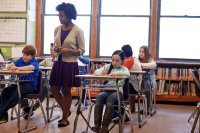3 Simple Ways to Improve ELA Instruction
Knowing who students are is a starting point for sparking their creativity and tailoring instruction to meet their needs.
Your content has been saved!
Go to My Saved Content.When I began teaching eighth graders 15 years ago, I knew a lot more about my English language arts (ELA) content than I did about my students or how to teach them. That year I tried to teach the way I had been taught: desks in rows with a one-size-fits-all approach to instruction. When I read their first essays that fall, it was clear that my approach was not effective. My students needed individualized instruction to meet their varied needs.
My first small successes in teaching came as I took the time to get to know the individual students in my classes. To do this, I used surveys, exchanged letters with them, and engaged them in conversations during lunch, in the hallways, and after class.
Learning about students’ backgrounds provided me with a starting point for sparking their creativity, giving them a purpose for writing, and tailoring instruction to achieve their literacy goals. Here are some of the strategies I’ve used over the years to get to know my students better and improve their ELA instruction.
Surveys
Surveys were one way I got to know my students better. I’d give them a survey about their interests, hobbies, and families to learn how to engage them. I’d also give them surveys that explored who they were as readers and writers. I asked questions like these: What is your all-time favorite book? What books have you read more than once? What was one memorable experience you’ve had with reading, good or bad?
Surveys like these helped me learn why Dante put his hood up each day and refused to read, for example. It wasn’t that he was being defiant, but rather that he hadn’t had previous success in reading. Because he was a reluctant reader, I used complex and engaging images to develop his thinking skills, like making inferences and citing evidence. Once he was engaged and felt successful, it was easier to transition to complex written work.
Shyla, on the other hand, read voraciously. I talked with her about the books she was reading and encouraged her to try new genres or authors she hadn’t yet been introduced to. If it hadn’t been for the survey, I might have missed this opportunity to help an accomplished reader grow.
Letters to and From Students
Each year I begin with a letter to my students. This letter details who I am as a teacher, reader, and writer, and also who I am as a person outside of school. I share about my family, hobbies, and interests, and who I was as a middle school student. I invite them to make annotations and tell them that this will help me begin to learn how they make meaning when they read. Reading their annotations then becomes my first assessment of who they are as readers, thinkers, and people.
I then give my students their first writing assignment: write a letter back to me. I tell them to treat this writing assignment seriously, as it will be my first assessment of who they are as writers and it will help me see where I can support their growth this year. Their letters also give me a window into who they are, and this information has been valuable for planning instruction and interacting with students throughout the year.
I’ve used this information in creating my first revised seating chart, for example. I’ve moved students closer to the board or screen if they said they couldn’t see well and honored students’ preferences if they had trouble working with someone or had been bullied during a previous year. I’ve also used students’ letters in determining how to differentiate writing instruction and noting whom to check in with privately rather than cold call because of their anxiety.
Asking Questions and Listening
It’s important to note that getting to know my students has meant recognizing their value as individuals. I never expect classes to be the same as previous groups, and I never expect siblings or cousins to be the same as those relatives I’d had before them. Seeing each student as an individual means I look and listen for their uniqueness, and I let them know I highly value that individuality.
Informally, this might mean learning about students’ interests, families, or peer groups through conversations in the hallway or at lunchtime. These casual conversations have allowed me to choose texts that engage my students, which has made it easier to push their thinking. It has also made it possible to differentiate for interest. Because I knew Caleb loved working on cars and Jocelyne was a self-described tech nerd, for example, I chose articles about the pros and cons of driverless cars as one option for writing about argumentative texts.
Listening to students goes beyond paying attention to what they say—it also means being mindful of changes in their behavior, as when Brianna, for example, had grown quieter and less careful with her work. It was a small change and didn’t disrupt the class, but because I was watching closely, I noticed a difference.
When I asked her about it after class, she began to cry. Her family had been evicted and were living in their car. She was staying composed at school, but barely, and her focus was suffering. I was better able to provide her with appropriate accommodations, like printed copies of online research and extra time with writing assignments, because these adjustments ensured equity given her situation and supported her learning despite her circumstances.
If I hadn’t noticed or inquired, I might have thought she was sullen, lazy, or even defiant. Knowing my students meant understanding the context of their behaviors and learning, and it meant that I was better able to support their learning.
